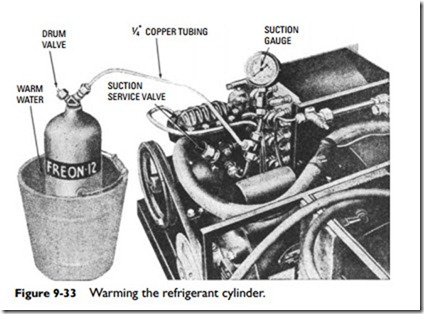Evacuating the System
Sometimes it becomes necessary to remove the entire refrigerant charge from the system. This operation is referred to as evacuating the system and is accomplished as follows:
1. Close the discharge service valve stem by turning it clockwise and remove the gauge connection plug.
2. Open the inlet service valve by turning the stem counterclockwise and attach a compound gauge to the inlet service valve.
3. Close the valve 1⁄2 turn clockwise and start the unit discharging through the open gauge connection in the discharging service valve.
Warning
Capture the evacuated refrigerant. It is illegal to release the refrigerant to the atmosphere.
If a vacuum is pumped too rapidly, the compressor will have a tendency to pump oil out of the compressor crankcase. Attach a copper tube to the gauge port and bend it so that any oil pumped out may be drained into a container. During this operation, the compressor may knock.
If knocking occurs, stop the compressor for about a minute and then restart. Continue the process until the gauge indicates a 20- inch vacuum or better. At this point, leaks in the system may be detected by putting sufficient oil in the container to cover the end of the tubing and continuing the pumping operation. When the system is entirely evacuated, no more bubbles should appear in the oil container. After the system is fully evacuated, replace the discharge gauge connection plug or attach a pressure gauge as desired.
Charging
Charging is the addition of refrigerant to a system from an external drum. There are a number of ways to add a refrigerant charge to a system, but the safest method usually is to introduce the refrigerant through the liquid line. The procedure may be outlined as follows:
1. Connect the refrigerant cylinder to the liquid line port at the condenser or compressor.
2. Purge the connecting line and tighten the last connection.
3. Disconnect the compressor so that it will not run during the charging operation.
4. Turn on the blower to the condenser.
5. Warm the refrigerant cylinder by placing it in a bucket of warm water (see Figure 9-33). Do not immerse any refrigerant connections.
6. Remove the cylinder from the water when you are satisfied it has been thoroughly warmed.
7. Wipe the cylinder dry and invert it.
8. Open the cylinder valve and the charging port valve.
The refrigerant should flow very readily into the high-pressure side of the system if steps 1–8 were carefully followed.
After the system has been charged, close the refrigerant cylinder valve, allow 2 or 3 minutes to pass, and disconnect the cylinder. Reconnect the compressor and operate the unit, using gauges to determine if the charge is sufficient.
Always exercise caution when making connections or disconnections on the liquid line. This line is under high pressure, and the refrigerant is in a liquid form. Guard against refrigerant spraying into the face and eyes. Any minor leakage that may occur around the refrigeration hose in disconnection will be cold and at high pressure. To minimize pressures, liquid line disconnections should be made after the unit has been shut down for at least 5 minutes.
If the refrigerant charge is introduced in the low-pressure side of the system, the charging cylinder should always be kept in a vertical
position. This precaution prevents the refrigerant liquid from flowing into the crankcase of the compressor.
Never heat a refrigerant cylinder with a torch or any other type of flame. Warming a cylinder in this manner generates excessive pressures, which can result in an explosion. Always use warm water to heat a refrigerant cylinder.
